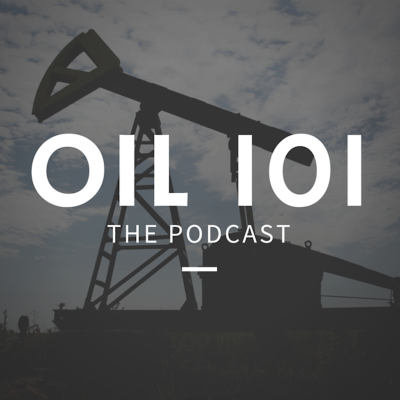
Oil 101 - An Introduction to Oil and Gas
Podkast av EKT Interactive
Prøv gratis i 7 dager
99,00 kr / Måned etter prøveperioden.Avslutt når som helst.

Mer enn 1 million lyttere
Du vil elske Podimo, og du er ikke alene
Rated 4.7 in the App Store
Les mer Oil 101 - An Introduction to Oil and Gas
Oil 101 - The Oil and Gas Learning Podcast. Oil 101 is the first podcast to focus on topics relevant to those who are looking to learn more about the oil and gas industry. Whether new to oil and gas, looking to get started in the industry, or someone just looking to learn more about their profession. In this podcast we will discuss the fundamental segments of the oil and gas industry - Upstream, Midstream, and Downstream. We then drill down further into specific functions including Exploration, Drilling, Production (E&P), Natural Gas, Refining, Supply and Trading, and Petroleum Product Marketing. After covering these key functions of oil and gas, we get into our 'What is..?' segment where we discuss topics such as, 'What is Upstream vs Downstream'. We look forward to being an integral part of your oil and gas training and a key to lifelong learning in this dynamic and complex industry.
Alle episoder
24 EpisoderWHAT IS DOWNSTREAM? In this episode of the Oil 101 [https://ektinteractive.com/oil-101] podcast series, we will discuss the fundamentals of the Downstream segment of the oil and gas industry [https://ektinteractive.com/upstream-vs-downstream/]. Key Downstream business sectors include refining, supply and trading, and marketing. In this 8-minute podcast, we will discuss: * What is Downstream? * Characteristics of the Downstream segment of the oil and gas industry * Refining and characteristics of crude oil * Some participants in Downstream * Consumption – the final link in the value chain * The current global energy mix * Marketing and retail Listen to Midstream 101 below… THANKS FOR LISTENING TO THE EKT INTERACTIVE OIL AND GAS PODCAST NETWORK [HTTPS://EKTINTERACTIVE.COM/OIL-AND-GAS-PODCAST]. RELATED RESOURCES: What is Upstream? [https://ektinteractive.com/what-is-upstream/] What is Midstream? [https://ektinteractive.com/what-is-midstream/] What is Downstream? [https://ektinteractive.com/what-is-downstream/] What is Refining? [https://ektinteractive.com/refining/] What is Petroleum? [https://ektinteractive.com/what-is-petroleum/] What is the difference between Upstream and Downstream? [https://ektinteractive.com/upstream-vs-downstream/] Drilling Wells for Oil and Gas [https://ektinteractive.com/drilling/drilling-well/] and Offshore Drilling [https://ektinteractive.com/offshore-drilling/] Oil 101 [https://ektinteractive.com/oil-101] TRANSCRIPT: Hi, and welcome to Oil 101, the podcast. My name is Doug Stetzer and I'm content and community manager for EKT Interactive. This content is taken from our Fundamentals of Downstream ebook which is available in our free members content library. If you missed our previous episodes on upstream, and midstream, be sure to go check those out. So, What is Downstream? Processing, transporting and selling refined products is the business of the downstream segment of the oil and gas industry. Key downstream business sectors include: * Oil Refining * Supply and Trading * Product Marketing and Retail The downstream industry provides thousands of petroleum products [https://ektinteractive.com/what-is-petroleum/] to end-user customers around the globe. Many products are familiar such as gasoline, diesel, jet fuel, heating oil and asphalt for roads. Others are not as familiar such as lubricants, synthetic rubber, plastics, fertilizers and pesticides. Business Characteristics of the Downstream Segment The downstream segment is a margin business. Margin is defined as the difference between the price realized for the products produced from the crude oil and the cost of the crude oil delivered to the refinery. Although the price of crude sets the absolute level of product prices, it may or may not affect refining or marketing margins. Downstream margins tend to be reduced, or squeezed, when crude price increases can not be recovered in the marketplace. On the other hand, margins tend to hold, or even increase, when crude prices drop and the marketplace more slowly adjusts to these lower crude prices. The downstream segment includes complex and diverse activities including manufacturing, petrochemical refining, distribution, and retail. A global perspective is important because of the global nature of the energy supply chain as well as the impact of supply and demand on both feedstock and product prices. Crude oils are not uniform, but rather are mixtures of thousands of different compounds called hydrocarbons. Each component of each compound has its own size, weight, and boiling temperature Lets talk about refining. Refineries process crude oil into a variety of useful products through a number of different processing units using heat and pressure to separate the products. The resulting petroleum products are often classified as light, medium, or heavy. Light products include Liquid Petroleum Gas (or LPG), Gasoline, and Naphtha, which is used as a solvent or paint thinner. Medium products, or what are called middle distillates, include kerosene and related jet aircraft fuels as well as diesel fuel. Heavy products include fuel oils, lubricating oils, paraffin wax, asphalt and tar, and petroleum coke. Who are some of the key downstream participants? Downstream participants include refining and marketing divisions of the major integrated oil companies as well as independents. Integrated Refiners include: BP ExxonMobil Chevron Shell Total Independent Refiners: Valero Tesoro Sunoco Independent refiners will often have a chain of service stations to market their products. What makes them an independent is the fact that they have no upstream E&P operations. Consumption The final link in the oil and gas value chain is consumption. At the end of the day, it is the end users or customers of oil and gas products that give them their ultimate value. Globally, the most widely known crude oil product is gasoline. In addition to the well-known products of gasoline, jet fuel and diesel fuel, the downstream industry touches every consumer. Further processing produces lubricants, waxes and specialty products, such as high quality oils for medicines and cosmetics. Raw materials from the downstream are procured for the petrochemical industry as feedstock in the production of thousands of additional products such as synthetic rubber, plastics, nylon, polyesters for fabrics, fertilizers, antifreeze, pesticides and pharmaceuticals. Natural gas products do not generally require more processing than was discussed in the podcast on midstream. Just to compare to the refined oil products, Natural gas products include: Natural gas itself used in electricity generation and as fuel for home heating and cooking. Liquefied Natural Gas (LNG) a cooled, liquefied version of natural gas used to ease shipment and storage. Natural Gas Liquids (NGLs) which are used as raw materials in oil refining and petrochemical manufacturing. and Compressed natural gas used as fuel for buses and commercial vehicles. Consumption Current Global Energy Mix Let's discuss the current global energy mix. Each region in the world has a different mix of hydrocarbon or fossil fuels needed and used to meet their total consumption. Oil remains the leading energy source in North, South and Central America and the Middle East. Fuel products (gasoline, diesel and jet fuel) are 65% of total demand for refined products in the US and 40% of total global demand. Alternatively, coal dominates in the Asia Pacific region while natural gas is the leading fuel in Europe and Eurasia. As all global economies continue to expand, there will be continual balance and tradeoffs made between the fuel qualities, pricing and environmental impact of coal, oil and gas. Marketing and Retail Petroleum product marketing [https://ektinteractive.com/what-is-petroleum/] is the business of finding and supplying customers who possess either internal demand for refined fuels or distribution networks for reaching retail customers. Direct consumers of energy products include petrochemical and industrial manufacturers, utilities, municipalities, trucking fleets, and airlines. Other companies may possess distribution assets or brands aimed at reaching retail end users. These companies could include independent service station suppliers, motor oil products, home fuel oil supply companies, propane tank distributors, and many others. The network of service stations, dealers, and jobber-distributors is a large franchise system similar to the fast food chains familiar to everyone. There are approximately 110,000 independent gas stations in the US. Downstream Oil and Gas Summary In Summary, the downstream segment of the oil and gas industry includes the refining of crude oil into consumable products and the marketing of these products to commercial or retail end users. Downstream is a very complex, global business where profit is made from the margin between crude oil and refined products. Gasoline, jet fuel, and diesel account for over 40% of global demand for refined products. Thanks for listening, and we hope you've learned a few things about the downstream segment of the oil and gas industry. Be sure to share this as you see fit, and review us on itunes if you have a chance. Your feedback really helps us improve as we move forward. The post Oil 101 – Introduction to Downstream Oil and Gas [https://ektinteractive.com/podcast/oil-101-podcast/003-oil-101-downstream/] appeared first on EKT Interactive [https://ektinteractive.com].
CONVENTIONAL VS UNCONVENTIONAL RESOURCES In this episode of the Oil 101 [https://ektinteractive.com/oil-101] podcast series, we will briefly discuss the key differences between conventional and unconventional resources as they pertain to oil and gas drilling and production. In this 3.5-minute podcast, we will discuss: * Conventional oil and gas exploration * Unconventional oil and gas exploration * Examples of unconventional oil and gas resources Listen to Oil 101 – Conventional vs Unconventional Resources below: Learn more about our Online Oil and Gas Training Courses [https://ektinteractive.com/oil-and-gas-training/] Thanks for listening to the EKT Interactive Oil and Gas Podcast Network [https://ektinteractive.com/oil-and-gas-podcast]. RELEVANT LINKS: * Oil 101 – A Free Introduction to Oil and Gas [https://ektinteractive.com/oil-101] * Episode 1 – Upstream 101 [https://ektinteractive.com/podcast/oil-101-podcast/001-oil-101-upstream/] TRANSCRIPT: > There are two fundamentally different types of hydrocarbon resources: conventional and unconventional. Each type affects the exploration approach, drilling methods and commercial development strategy. CONVENTIONAL EXPLORATION A conventional oil & gas resource is found in those reservoirs where the hydrocarbon is recovered through classic exploration techniques and vertical or deviated wellbores. Most conventional hydrocarbon reservoirs have defined geological limits, with classic characteristics such as a source rock, seals, salt domes, traps and cap rock. These reservoirs are grouped by E&P companies [https://ektinteractive.com/oil-companies] into plays or discrete fields as development is anticipated and managed. For conventional resources, the key economic driver is the exploration well or wildcat success. This well is drilled, logged, and maybe cored, and well productivity is then fairly easy to establish using conventional logging and evaluation techniques. The major economic uncertainty is associated with the size and productivity of the overall reservoir. UNCONVENTIONAL EXPLORATION Unconventional resources are controlled by wide regional geology, not a local reservoir. This leads to accumulations that cover huge areas often with poorly defined limits. In unconventionals, the word field is used more often to mean an administrative unit. For unconventional resources such as shale oil, shale gas, oil sands, bitumen and coalbed methane, the priorities relative to conventional E&P are reversed. Typically, you know where all the hydrocarbons are located. The key to success is whether they can actually be economically produced, or brought to the surface. Here, exploration is more like development and may require years of detailed geologic studies, great expense for numerous delineation wells, and long periods of testing called pilot projects. Unconventional deposits require different and much more complex and costly production methods. Further, unconventional oil, especially from oil sands, may need additional upgrading to be usable as a refinery feedstock. In summary, unconventional resources are more capital intensive (for development, production, and upgrading) than conventional ones. Future prospects for unconventional resources depend on the crude and natural gas price and the investment cost and technology needed to convert them into commercially usable reserves. The total amount of unconventional oil and gas resources in the world considerably exceeds the amount of conventional reserves. BUT will not be developed unless the price is right. RELATED RESOURCES: What is Upstream? [https://ektinteractive.com/what-is-upstream/] What is Midstream? [https://ektinteractive.com/what-is-midstream/] What is Downstream? [https://ektinteractive.com/what-is-downstream/] What is Refining? [https://ektinteractive.com/refining/] What is Petroleum? [https://ektinteractive.com/what-is-petroleum/] What is the difference between Upstream and Downstream? [https://ektinteractive.com/upstream-vs-downstream/] Drilling Wells for Oil and Gas [https://ektinteractive.com/drilling/drilling-well/] and Offshore Drilling [https://ektinteractive.com/offshore-drilling/] Oil 101 [https://ektinteractive.com/oil-101] The post Oil 101 – Conventional vs Unconventional Resources [https://ektinteractive.com/podcast/oil-101-podcast/014-oil-101-conventional-vs-unconventional-resources/] appeared first on EKT Interactive [https://ektinteractive.com].
WHAT IS MIDSTREAM? In this episode of the Oil 101 [https://ektinteractive.com/oil-101] podcast series, we will discuss the fundamentals of the Midstream segment of the oil and gas industry [https://ektinteractive.com/what-is-midstream]. If Upstream is all about the wells, Midstream is all about processing, moving, and storing the produced oil and gas. In this 13-minute podcast, we will discuss: * What is Midstream? [https://ektinteractive.com/what-is-midstream/] * Characteristics of the Midstream segment of the oil and gas industry * Some participants in Midstream * Oil and natural gas processing * Transportation – gathering systems, pipelines, rail, more * Storage – methods and differences between oil and natural gas Listen to Midstream 101 below… LEARN MORE ABOUT OUR OIL AND GAS TRAINING CERTIFICATE. [HTTPS://EKTINTERACTIVE.COM/OIL-AND-GAS-TRAINING/] THANKS FOR LISTENING TO THE EKT INTERACTIVE OIL AND GAS PODCAST NETWORK [HTTPS://EKTINTERACTIVE.COM/OIL-AND-GAS-PODCAST]. PROGRAM NOTES * Oil 101 – A Free Introduction to Oil and Gas [https://ektinteractive.com/oil-101] * Episode 1 – Upstream 101 [https://ektinteractive.com/podcast/oil-101-podcast/001-oil-101-upstream/] * EIA US Energy Mapping System [http://www.eia.gov/state/maps.cfm?v=Petroleum] – Amazing tool! * EIA – Map of underground natural gas storage facilities [http://www.eia.gov/cfapps/ngqs/images/storage_2011.png] * Article: Natural Gas Liquids (NGLs) Boom [https://ektinteractive.com/natural-gas-liquids-ngls-boom/] TRANSCRIPT: > Hi, and welcome to Oil 101, the podcast. My name is Doug Stetzer and I'm content and community manager for EKT Interactive. Today we will be discussing the Midstream segment of the oil and gas industry. This content was developed by industry experts with decades of experience and used at Fortune 10 companies, oil and gas super-majors [https://ektinteractive.com/oil-companies], financial services firms, and many more. Our Fundamentals of Midstream ebook is available in the free members content library at www.ektinteractive.com. So, What is Midstream? [https://ektinteractive.com/what-is-midstream/] As its name implies, the midstream [https://ektinteractive.com/what-is-midstream/] segment of the oil and gas industry encompasses facilities and processes that sit between the upstream and downstream segments. Activities can include processing, storage and transportation of crude oil and natural gas. In most cases, oil and gas reserves are not located in the same geographic location as refining assets and major consumption regions. Transportation is a big part of midstream activities and can include using pipelines, trucking fleets, tanker ships, and rail cars. Characteristics of the Midstream Segment The midstream segment is separated from upstream and downstream [https://ektinteractive.com/upstream-vs-downstream/] in most integrated oil companies because it is considered a low risk, regulated type of business. It does not fit the risk profile or asset complexity of the other segments of the oil and gas industry. Success in midstream depends on many external forces including Upstream operation's continuous delivery of reserves and refinery margins that encourage refined product production. Natural gas price levels that impact the attractiveness of NGL's as feedstock also impact midstream. Healthy downstream [https://ektinteractive.com/what-is-downstream/], natural gas, and petrochemical markets are important to the midstream [https://ektinteractive.com/what-is-midstream/] segment. After all, those segments contain a midstream operator's customers. Finally political sentiment for pipeline expansion and not in my backyard hurdles can be challenges to midstream expansion. While the midstream [https://ektinteractive.com/what-is-midstream/] gathering and processing sector is relatively free of commercial regulation, the movement of oil and gas by interstate pipelines and subsequent state level distribution activities are highly regulated in the US by the Federal Energy Regulatory Commission (FERC) [http://www.ferc.gov]. Further, cross-border pipeline expansions can require approval from the Executive branch and become part of the national political debate. We've seen this scenario play out publicly with the segment of the proposed Keystone XL pipeline linking Canadian oil fields with US pipelines and refining capacity Midstream Participants Some of the largest North American midstream oil companies [https://ektinteractive.com/what-is-midstream/] include Enterprise Products, Kinder Morgan, Enbridge, TransCanada, Williams Companies, Plains All-American, and Koch Industries. These participants are categorized by the portfolio of midstream assets they own, such as distribution, storage, processing, fractionation, and marketing. These assets will be discussed further in subsequent episodes and are covered in some of our upcoming more in depth content. We'll be sure to add links to the transcript as they become available. Oil and Gas Processing Next Step in Adding Value So, while producing crude oil and natural gas is the goal of upstream, processing oil and gas liquids into marketable products is the beginning of the midstream segment of the business. These products then continue into the refining or processing portion of the downstream segment. Field processing is the first phase of oil and gas processing starting in the onshore or offshore production field. Here, surface facilities are designed and installed that: * Measure the production rate of the oil, gas, and water that is produced from the reservoir * Separate the oil, gas, and water from one another * Remove impurities to prepare the crude or gas for sale or the next process * Temporarily store the crude or gas until it is ready to be moved to the next process Fractionation plants, which remove natural gas liquids (NGL) from the produced oil and gas are also a component of the midstream activities. These NGLs are used as blend components in a refinery and used as fuel or feedstock in the manufacture of petrochemicals. We have more materials as well as some articles on recent developments in the NGL markets that we'll link to in the program notes. Transportation After field processing, treated oil and gas is delivered via complex transportation, transmission and distribution infrastructure. Crude oil and refined liquids start their journey in a spider web of small-diameter field gathering pipelines. Once accumulated, larger volumes are moved along the coast or through rivers in smaller barges and transported internationally in tankers or vessels. Land transportation methods include pipelines, truck and rail. Natural gas, which flows at much higher pressure than crude oil, is most often transported in large-diameter, high-pressure-handling pipelines called transmission lines. A common point of confusion in our industry, whether you're new to it or not, is NGLs vs LNG. Natural Gas Liquids vs Liquified Natural Gas. NGL, LNG What's the Difference? NGL is an acronym for Natural Gas Liquids which are the liquid hydrocarbons normally associated with Natural gas. Most common NGLs are methane, ethane, and heavies like propane and butanes. Depending on the gas pressure, the heavies will condense and constitute the liquid or wet portion of the natural gas. You will commonly hear differentiation in natural gas fields as to whether they are predominantly wet or dry. NGLs are much more valuable as raw material for further processing than as fuel for simple combustion. LNG on the other hand is an acronym for Liquefied Natural Gas the gaseous portion of natural gas (mostly the methane and a little ethane) in the liquefied state which occurs at -260 oF. LNG is an efficient way to move, transport and handle large quantities of natural gas instead of trying to store it in the gaseous state at elevated pressures. While pipelines are the safest and most efficient and way to transport oil and gas, trucks and rail are more flexible in terms of timing and destination. Adding new pipeline infrastructure takes considerable time and investment, and often faces political resistance. The recent growth in domestic US production has led to an expansion of crude-by-rail shipments since many new fields are not connected to existing pipeline infrastructure. A lack of pipelines exist to directly service domestic refining centers in the Northeast and Gulf Coast as these have traditionally been supplied by oil imported from overseas. This concept will be discussed more in depth in the Industry Trends module. Storage Moving on from transportation, let's discuss storage. The methods of storage for crude oil and natural gas are quite different, so we'll break down each group separately. Crude Oil Storage facilities for crude oil and refined liquids is pretty straight forward. Methods include bulk terminals, refinery tanks and holding tanks to get material into pipelines, or ready to be shipped on a vessel. Cushing, OK is the delivery point for the NYMEX/CME [http://www.cmegroup.com/] crude oil futures contract. As such, it is an important storage location for traders looking to deliver oil against these contracts. There is currently storage capacity to hold about 65 million barrels of oil at this location (up from about 26 million in 2005). The Strategic Petroleum Reserve (SPR) is an emergency storage of oil maintained by the US Department of Energy [http://www.energy.gov/]. Current storage capacity is approximately 727 million barrels, with about 695 million barrels (or 36 days consumption) in inventory. Can anyone guess what brought about the development of the SPR? If you guessed the oil embargo of 1973-74 you're right. This supply disruption really exposed just how reliant the US was on imported oil at that time. Natural Gas Natural gas is another story. Because of its extremely high pressure, natural gas must be stored in underground reservoirs until it is ready to be transported to market. Most commonly depleted gas reservoirs are used, with gas being injected back into the ground to await it's next move. Salt caverns and aquifers are other storage possibilities. There is approximately 3.5 trillion cubic feet of working gas in nearly 400 facilities in the US. Midstream Oil and Gas Summary The midstream segment of the oil and gas business concentrates on the processing, transportation, and storage of crude oil and natural gas. Midstream activities [https://ektinteractive.com/what-is-midstream/] are considered a low-risk, highly-regulated segment of the oil and gas industry. Field processing is the first phase of oil and gas processing starting in the onshore or offshore oil or gas production field. Fractionation plants, which remove natural gas liquids (NGL) from the produced oil and gas are also a component of the midstream activities. After field processing, treated oil and gas is delivered via a complex transportation, transmission and distribution infrastructure. Storage facilities for crude oil and refined liquids include bulk terminals, refinery tanks and holding tanks. Because of its extremely high pressure, natural gas must be stored in underground reservoirs until it is ready to be transported to market. Thanks for listening, and we hope you've learned a few things about the midstream segment of the oil and gas industry. Be sure to share this as you see fit, and review us on itunes if you have a chance. Your feedback really helps us improve as we move forward. If you want more information about our Oil 101 [https://ektinteractive.com/oil-101] content go to www.ektinteractive.com and register to access our free content library. See you next time. The post Oil 101 – Introduction to Midstream Oil and Gas [https://ektinteractive.com/podcast/oil-101-podcast/002-oil-101-midstream/] appeared first on EKT Interactive [https://ektinteractive.com].
OIL 101 – WHAT IS NATURAL GAS? The first 10 episodes of the Oil 101 podcast [https://ektinteractive.com/series/oil-101-podcast/] have covered the ‘Microbes to Markets’ journey of getting hydrocarbons out of the ground, converting them to useful products, and bringing them to consumers. Now we turn to the ‘What is…?’ portion of Oil 101. We started with the most basic of oil and gas questions,What is Crude Oil?, now let’s do a quick discussion of ‘What is Natural Gas?’. In this episode of the Oil 101 podcast series, we will discuss what exactly crude oil is and some of the key components of crude oil that affect it being refined into useful petroleum products. In this 6-minute podcast, we will discuss: * What is natural gas? * Associated vs non-associated gas * What makes natural gas ‘clean’ * Measuring natural gas – heating value and volume * Uses of natural gas Listen to ‘What is Crude Oil’ below: LEARN MORE ABOUT OUR OIL AND GAS TRAINING CERTIFICATE. [HTTPS://COURSES.EKTINTERACTIVE.COM] THANKS FOR LISTENING TO THE EKT INTERACTIVE OIL AND GAS PODCAST NETWORK [HTTPS://EKTINTERACTIVE.COM/OIL-AND-GAS-PODCAST]. RELEVANT LINKS: * Oil 101 – A Free Introduction to Oil and Gas [https://ektinteractive.com/oil-101] * American Gas Association – AGA [http://www.aga.org] * Podcast: Introduction to Natural Gas [https://ektinteractive.com/podcast/oil-101-podcast/012-oil-101-what-is-natural-gas/] TRANSCRIPT: > WHAT IS NATURAL GAS? [HTTPS://EKTINTERACTIVE.COM/WHAT-IS-NATURAL-GAS/] Natural gas, like crude oil and coal, is a mixture of hydrocarbon compounds which are multiple combinations of carbon and hydrogen atoms. As far as the oil and gas industry is concerned, natural gas occurs in two principal forms: associated gas and non-associated gas. Associated gas occurs in conjunction with crude oil reservoirs either dissolved in the oil or occurring separately in the same reservoir. Since it separates from the oil at the casing head of the production well, it is also known as casing head gas or oil well gas. There are huge quantities of associated gas produced with Middle East crude oil. Associated gas often is re-injected into the producing well to raise the pressure to get more oil out of the well, or held in the reservoir until a distribution system can be developed to move the gas to market. Non-associated gas occurs in gas-only reservoirs separate from crude oil. The majority of US natural gas production is non-associated gas. The principal components of natural gas are methane and ethane with varying amounts of heavier hydrocarbons including propane, butane and pentane. Methane is a light hydrocarbon. It has a relatively low boiling point, so at room temperature it is a gas. Natural gas is the cleanest of all the fossil fuels. The main products of the combustion of natural gas are carbon dioxide and water vapor, the same compounds we exhale when we breathe. Unlike coal or oil, combustion of natural gas releases very small amounts of sulfur dioxide and nitrogen oxides, virtually no ash or particulate matter. HOW NATURAL GAS IS MEASURED Like crude oil, natural gas has a variety of global and US measurements. We will focus on Heating Value and Volume measurements. HEATING VALUE BTU Natural gas, like other forms of energy, is measured in terms of heating value, or British thermal units, often called BTUs. Natural gas is valued for its heating ability with end use heating values generally ranging between 950 and 1150 Btu per cubic foot. One Btu is the heat required to raise the temperature of one pound of water one degree Fahrenheit. To put the Btu in perspective, ten burning matches release 10 Btu. VOLUME CUBIC FOOT When measuring volume, natural gas is commonly measured in cubic feet. One cubic foot of natural gas releases approximately 1,031 Btu. Natural gas reserves are measured in terms of volume as Millions , billions or even trillions of cubic feet (TCF). or billions of cubic meters (BCM or Bm3). In natural gas production, prolific wells produce and deliver hundreds of thousands or even millions of cubic feet of gas per day (MMcfd). Purchases and sales of natural gas are generally measured in millions of BTU's (MMBTU's). Transportation capacity of natural gas, which is a function of pipeline size and compression capability, generally is measured as a consistent stream, expressed in volume per day – such as million or billion cubic feet per day. Pipeline size is measured in terms of pipe diameter. Compression is measured in terms of pressure relative to atmospheric pressure at sea level, expressed as pound-force per square inch gauge (psig). WHAT IS NATURAL GAS USED FOR? Because of its clean burning characteristics and heating value, natural gas is used around the world as follows: * Residential sector users are housing units. Natural gas uses include heating, cooking, and fueling appliances such as water heaters and clothes dryers. * Commercial sector users consist of business and government facilities. Common uses of natural gas associated with this sector also include space and water heating, air conditioning, lighting, refrigeration and cooking just on a scale larger than residential. * Industrial sector users consist of all facilities and equipment used for producing, processing or assembling goods. Industrial uses parallel those of commercial users. As examples, natural gas is used to fuel industrial processes, such as heat treating steel or manufacturing glass. It is also a feedstock for other chemical products such as fertilizer. * Power generators are utilities that produce, transfer and sell electricity. Power generators, the largest sector of industrial sector users, burn natural gas (and other fuels) to produce electric power. A gas-fired power plant has much lower emissions of carbon dioxide (CO2) and nitrous oxides (NOx) than coal or oil-fired plants. The post Oil 101 – What is Natural Gas? [https://ektinteractive.com/podcast/oil-101-podcast/012-oil-101-what-is-natural-gas/] appeared first on EKT Interactive [https://ektinteractive.com].
WHAT IS THE NELSON COMPLEXITY INDEX? In this brief 2-minute podcast, we discuss the Nelson Complexity Index [https://ektinteractive.com/podcast/oil-101-podcast/oil-101-nelson-complexity-index/]as it pertains to refinery complexity in downstream oil and gas [https://ektinteractive.com/upstream-vs-downstream]. Listen to Oil 101 – Nelson Complexity Index below or view all Oil 101 podcast episodes [https://ektinteractive.com/series/oil-101-podcast/]: Thanks for listening to the EKT Interactive Oil and Gas Podcast Network [https://ektinteractive.com/oil-and-gas-podcast]. RELEVANT LINKS: Oil 101 – A FREE introduction to the oil and gas industry [https://ektinteractive.com/oil-101] What is Refining? [https://ektinteractive.com/refining/] What is the difference between Upstream and Downstream? [https://ektinteractive.com/upstream-vs-downstream] TRANSCRIPT: NELSON COMPLEXITY INDEX A refinery's complexity is assessed based on a concept known as the Nelson Complexity Index [https://ektinteractive.com/podcast/oil-101-podcast/oil-101-nelson-complexity-index/], or NCI. This concept, developed by W.L. Nelson in the 1960s, is a pure cost index that provides a relative measure of the construction costs of a particular refinery based on its crude and upgrading capacity. Under the Nelson Complexity Index, the most simple refinery that only distills crude oil, called a topping refinery, is considered to have a complexity factor of 1.0. All other processing units are rated in terms of their cost relative to this unit. For example, a catalytic hydrotreating unit has a complexity of 2.0 while a coking unit is assigned a complexity of 6.0. As more processes are added to a refinery, its complexity factor increases. While the complexity factor is independent of the refinery capacity, multiple units of the same process – multiple hydrotreaters for example – do increase complexity. A deep conversion refinery, with numerous and varying processes has the highest complexity factor of all, typically 9.0 or higher. As an example, Marathon Petroleum's most complex refinery is its Galveston Bay Refinery which had a Nelson Complexity Index factor of 15.3 as of 2013. The post Oil 101 – Nelson Complexity Index [https://ektinteractive.com/podcast/oil-101-podcast/oil-101-nelson-complexity-index/] appeared first on EKT Interactive [https://ektinteractive.com].

Rated 4.7 in the App Store
Prøv gratis i 7 dager
99,00 kr / Måned etter prøveperioden.Avslutt når som helst.
Eksklusive podkaster
Uten reklame
Gratis podkaster
Lydbøker
20 timer i måneden

































